
TO BE CONTINUED... Page 9 - Second part
Text by Nicole Bouglouan
Photographers:
Roger Ahlman
Pbase Galleries Peru and Ecuador & My bird pictures on IBC
Jean Michel Fenerole
Photos d’Oiseaux du monde
Steve Garvie
RAINBIRDER Photo galleries & Flickr Rainbirder
Tom Grey
Tom Grey's Bird Pictures & Tom Grey's Bird Pictures 2
Ken Havard
His bird pictures on IBC & Flickr gallery 1 et Flickr gallery 2
Patrick Ingremeau
TAMANDUA
Tom Merigan
Tom Merigan’s Photo Galleries
David Nowell
Virtually Home - Photo Gallery
William Price
PBase-tereksandpiper & Flickr William Price
Alan & Ann Tate
AA Bird Photography
Ingo Waschkies
My bird pictures on Pbase
Philippe and Aline Wolfer
OISEAUX D'ARGENTINE
Nicole Bouglouan
Photographic ramble & My pictures on IBC
These images and the text are subject to copyright and cannot be used without express authorization from the owners. Legal issues
Sources :
HANDBOOK OF THE BIRDS OF THE WORLD Vol 3 by Josep del Hoyo-Andrew Elliott-Jordi Sargatal - Lynx Edicions - ISBN : 8487334202
L’ENCYCLOPEDIE MONDIALE DES OISEAUX - Dr Christopher M. Perrins - BORDAS - ISBN: 2040185607
Wikipedia, the free encyclopaedia
Bird nests: Variety is Key for the world’s avian Architects
Be on the lookout for bird nests
The design and function of birds' nests
The bird and its nest, where everything starts…
Page 9: Jacanidae, Rostratulidae, Dromadidae, Haematopodidae, Ibidorhynchidae, Recurvirostridae, Burhinidae, Glareolidae
First part
At the beginning of the breeding season and following several courtship displays, the nest-site is selected by the pair, or one of the members of the pair, and the nest is built within this area. For numerous species, the nest is the place where displays and copulation occur. It plays a very important role during the nesting period. It is the cradle of the chicks, the place where the adults feed them prior to their first flight towards independence.
In the large order Charadriiformes, the Jacanidae belong to the assemblage of waders or shorebirds after being closely related to Gruiformes and Rallidae, due to fairly similar appearance with the latter. These small to medium-sized waterbirds are weak fliers but good swimmers, thanks to their lobed feet. The jacanas can be found in shallow freshwater wetlands throughout tropic and subtropic regions. They feed primarily on insects and a variety of invertebrates by gleaning from the aquatic vegetation or picking food items from the roots of small floating plants.
They breed on floating-emergent vegetation over water of 0,5 to 2 metres deep. Depending on the location, the birds nesting on reservoirs may nest over deeper water, on dense mounds of floating vegetation.
The jacanas exhibit sexual role reversal, and the males perform the nesting duties, although in a few species, the females may sometimes brood the chicks or defend them.

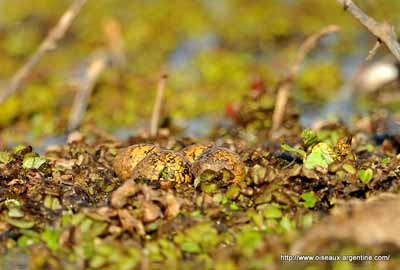
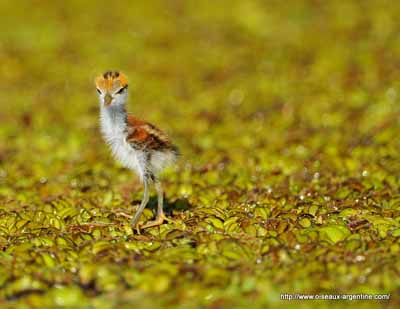
Nest with eggs
Four days old chick
They build several floating platforms used for courtship and copulation, and the female lays her eggs on one of these structures. These nests often resemble to the surrounding vegetation, but others consist of a mound of stems and pieces of aquatic plants. The upper surface of the nest sits above the water, and the eggs may sometimes be in contact with the water. The nests are affected by trampling by other animals, and are sometimes destroyed by variations of water levels.
Adult and chicks
The Rostratulidae family includes three species of painted-snipes. They are medium-sized waders and have a long bill. They have a superficial resemblance with the true snipes, but their plumage is brighter with more striking pattern.
They frequent a variety of wetlands such as estuaries and wet meadows in Argentina and Uruguay for the South American Painted-snipe, whereas the Greater Painted-snipe occurs in ricefields, freshwater lakes, mudflats and other wet areas in Africa, Madagascar, India, Pakistan and SE Asia and the Australian Painted-snipe frequents the same habitat type in Australia. They are omnivorous and feed on invertebrates including insects, snails, worms, crustaceans and seeds. They feed by probing in the mud around pools, marshes and wet areas.
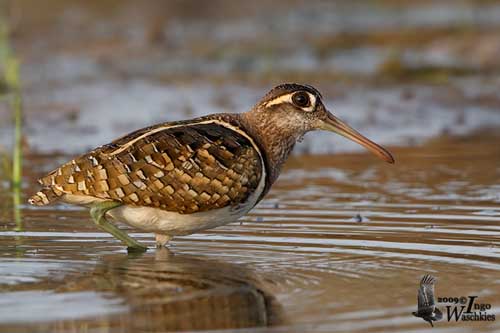
The painted-snipes exhibit sexual role reversal, and the males are slightly smaller and duller than the females. However, the females may sometimes incubate the eggs and rear the chicks. But usually, in both Greater Painted-snipe and Australian Painted-snipe, the male does all the nesting duties, while the female remains in the vicinity of the nest. It is solitary nester, but several nests can be seen together due to the polyandrous mating system.
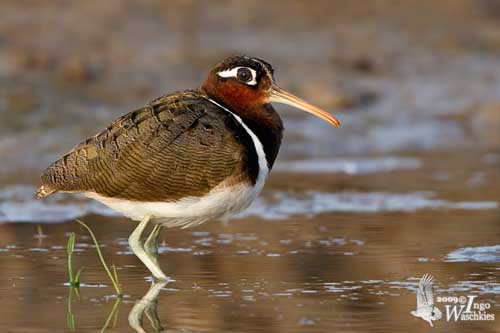
Female
The painted-snipes nest on the ground, and they start to build the nest some days prior to the laying, and it is completed while the second egg is laid. The nest is a shallow cup with a lining made with stems and leaves found in the vicinity of the nest-site. Some small dead sticks can be added sometimes. But this structure may be more elaborated and built as a small platform, with addition of more plant material.
The South American Painted-snipe is monogamous and tends to nest in wet pastures or grazing marshes. The Greater Painted-snipe builds its nest on grassy islets, like the Australian Painted-snipe which often nest on small islands too. Both are polyandrous and the male usually incubates, feeds and rears the chicks.
The family Dromadidae include only one species, the Crab Plover, found on coats of Indian Ocean. It is usually classified as a wader. It has heavy, thick, relatively short and dagger-like bill used for stabbing and breaking open the crab shells.
This black and white species is very gregarious even during the breeding season, and it nests in small to large colonies. It is monogamous.
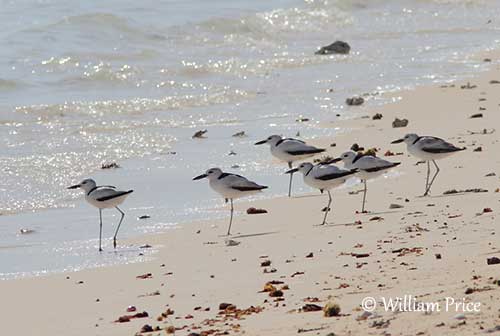
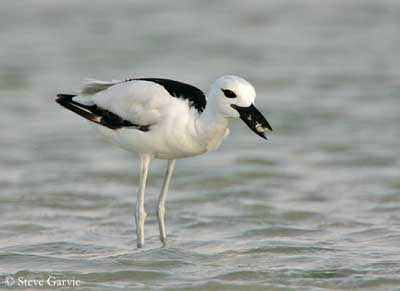
The Crab Plover nests in burrow dug in sandy soil or in flat coastal sand dunes. The nest chamber is unlined and placed at the end of the burrow of 1-2,5 metres long and about 20 centimetres in diameter. It is sloping downwards obliquely. At this deep point (50 centimetres depth), it rises slightly and opens out in order to form a chamber where the birds dig a hollow for the white egg. After hatching, the chick remains in the burrow for several days and it is fed by both parents. Once out of the burrow, it is still dependent on adults for food for long time.
The oystercatchers of family Haematopodidae can be found worldwide. They have black and white or all black plumage, red bill and eyering and pink legs and feet.
Most of them breed in coastal habitats including rocky shores and shingle and sand beaches. Some of them may nest inland such as some races of the Eurasian Oystercatcher. They usually move to coasts after breeding. They are territorial during the breeding season and defend their territories.
They feed primarily on arthropods such as earthworms and insect larvae. But they also consume bivalves, gastropods, amphipods, crabs, echinoderms and sometimes fish. This diet may vary according to the habitat of each species.
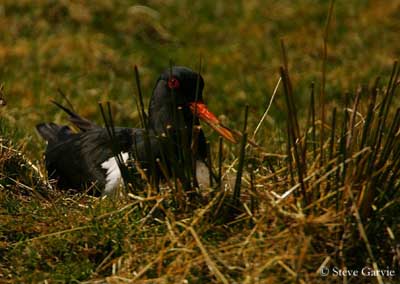
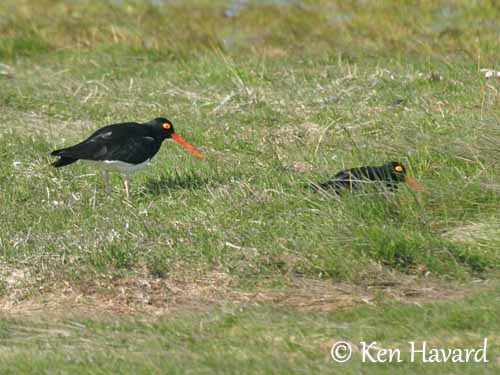
Oystercatchers are mainly monogamous, and bigamy is reported only for the Eurasian Oystercatcher. They breed during the summer months. They only produce a single brood, except for replacement clutch.
The nest is on the ground, a simple scrape which may be lined or not. The nest-site is usually sited in order to provide good visibility. Several scrapes are made, mainly by the male, but the female finally choses the nest where she will lay her eggs. Fidelity to mate and breeding site is often strong, and the same site can be used for several following years.
The Ibisbill is the sole member of the family Ibidorhynchidae and a very uncommon wader of flat stony rivers of CS Asia. Both appearance and behaviour may be distantly related to oystercatchers (Haematopodidae) and avocets and stilts (Recurvirostridae).
It feeds on a variety of insects and their larvae, and also takes crustaceans and small fish. It feeds by pecking, probing and raking, the latter while tilting the head to one side and working with the bill sideways through the pebbles.
They are solitary breeders, but with limited suitable nesting-sites, several nests can be seen in the same area, like a loose colony. This species is monogamous and territorial, and the territory is defended with aerial displays.
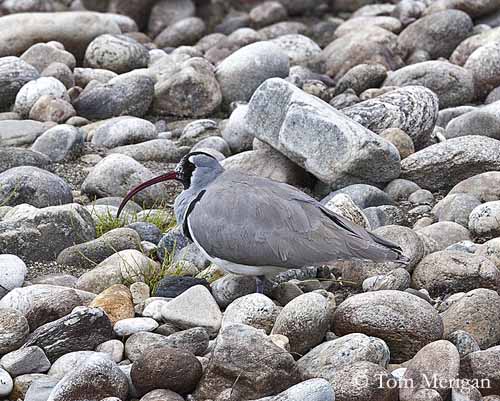
The nest is a depression on the ground, made in sandy shingle. It is sometimes lined with pebbles. It is built on a bank, island or peninsula along a river, sometimes up to 100 metres from the water.
Many nests are threatened by flooding with frequent changes of water levels in mountains due to snow, ice melting or increase of rainfall.
Stilts and avocets of the family Recurvirostridae are elegant aquatic birds with long legs and often black and white plumage. They have very long, flexible bills, well adapted to their foraging behaviour in fairly deep water.
They frequent extensive shallow wetlands providing them abundant small aquatic vertebrates and invertebrates. They tend to be gregarious and breed in colonies, although the Black Stilt defends a territory throughout the year and usually nests in solitary pairs. This species has long-term pair-bonds.
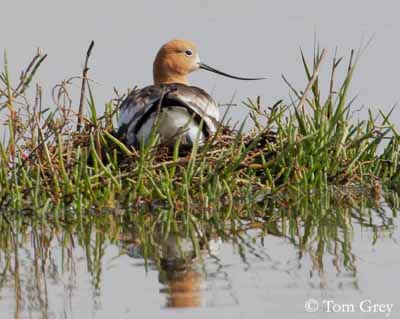
They initiate the nesting period only if local conditions are suitable, involving some variations of breeding periods. For the studied species, they tend to be monogamous for the season.
They nest usually in colonies in which the nests are spaced 5-30 metres apart. Avocets and stilts may nest together, but also with other waders, gulls, terns, and other species.
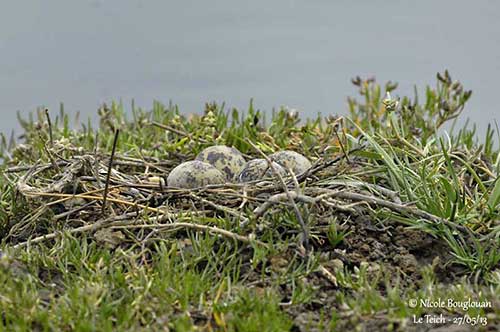
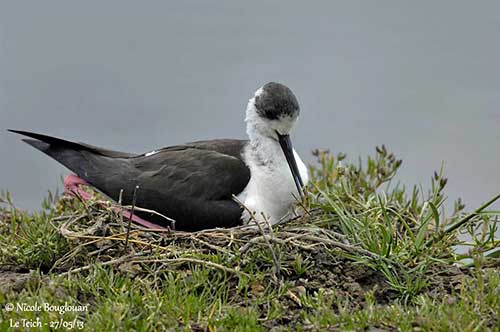
This nest was placed a few metres from a hide
This nest was placed a few metres from a hide
The nest varies with the species, and can be a small mass of material or more substantial, lined structure made with twigs, stems and other available vegetation. It is placed in open, among grass and sedges surrounded by shallow water.
The Banded Stilt may form huge colonies in sites of ephemeral nature such inland salt-lakes, involving desertion of the site at any time according to weather conditions. The nest of this species is a saucer-shaped depression on the ground, sometimes lined with some grass and stalks. The nest density can reach up to 18 nests /m².
The breeding success is highly variable between populations and seasons.
The thick-knees of the family Burhinidae are present on all continents except at the poles. They have cryptically coloured plumage, closely related to their habitat, usually dry, open country in tropical or subtropical zones. Most of them are sedentary.
They frequent low-lying, flat or rolling landscapes, and breed in arid or semi-arid deserts with only some vegetation. However, several species favour waterside habitats.
They spend the day in the shade of bushes, trees or rocks, and become active at dusk and night. They feed mainly on insects, but they also consume crustaceans, molluscs, worms, rodents and frogs. The thick-knees are terrestrial birds but they are able to perform sustained flight.
They usually breed during the dry season and are monogamous. The birds nesting close to the water lay their eggs on sandy banks when the water levels are low. They seem to be solitary nesters, but when the suitable nesting sites are restricted, they may form loose groups.
The Beach Thick-knee breeds in isolated pairs that may be resident in the same area for several years. It nests among mangroves or grass in a shallow depression. There is no lining, but sometimes a rim made with dead leaves and twigs.
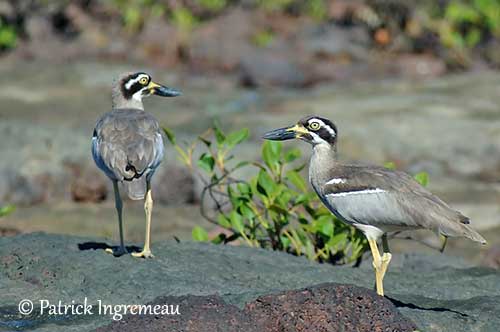
The nest is on the ground, a scrape selected through some displays during which several sites are investigated prior to choose the good one. The location of the nest-site varies with each species, from the shade provided by bushes or tree, to very open sites with little or no vegetal cover.
The Peruvian Thick-knee is probably solitary nester. Only one nest was described. It was a scrape cleared of plant debris, placed on rocky slope with scattered vegetation such as low shrubs and cacti.
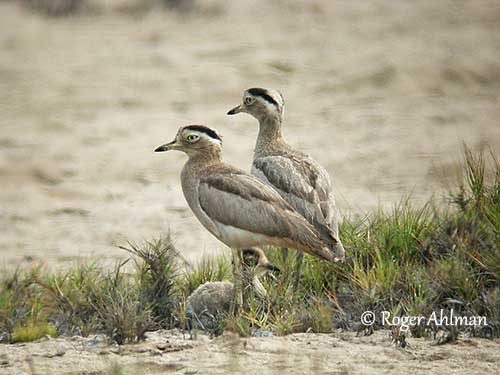
With chick
The eggs are laid into a shallow depression sometimes lined with some stones or shells found in the surroundings. The chicks are precocial and leave the nest 24 hours after hatching. Both parents share the nesting duties.
Coursers and pratincoles of the family Glareolidae are small to medium-sized terrestrial birds. They have a short, arched bill and the pratincoles have long, pointed wings and are mostly aerial feeders, whereas the coursers have shorter and more rounded wings, and long legs with short toes adapted to their terrestrial habits.
The arched bill characterizes all members of this family. The pratincoles have wide gape adapted to the catching of flying insects on the wing. The courser’s bill lacks the wide gape and is more adapted for digging for food in soft sandy soils.
The coursers are mainly found in dry regions, from Acacia woodlands and semi-arid scrub to desert. They may add molluscs to their insect diet and catch their prey on the ground by running, stopping and pecking at the food item.
The pratincoles are more or less closely associated with inland waters or occasionally estuaries. They are opportunists and take advantage of temporary insects swarms. They are mainly active at dusk.
Pratincoles breed in loose colonies, from a few pairs to hundreds of pairs. A small territory is defended and the nests are often several metres apart. On the other hand, the coursers are always solitary nesters.
The nest is on the ground, a shallow scrape or a hollow on a rock.
The Cream-coloured Courser nests in shallow depression without any lining. The nest is situated on the bare ground.
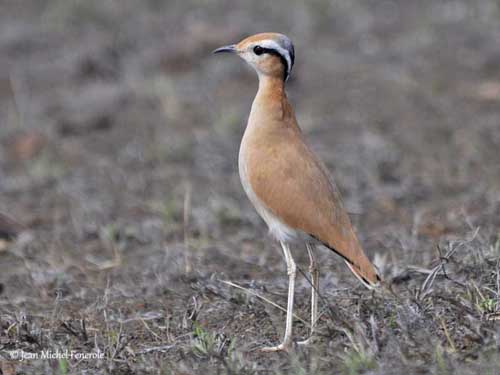
The small, loose colonies of Madagascar Pratincole may include up to 20 pairs, but sometimes only two. The nests are about 30 metres apart. The colonies are established on rocky islets in coastal waters or in large rivers. However, this species may also nests in limestone cavities. The nest is a shallow depression with only a few small sticks.
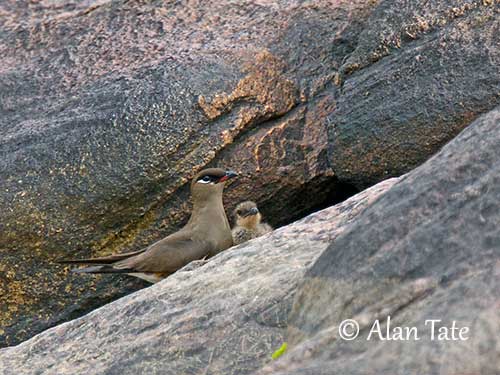
With chick
The Oriental Pratincole nests in loose colonies established on open plains and grassy islands on rivers, often with River Terns (Sterna aurantia). The nest is a scrape, a shallow depression on sandy or rocky ground.

Both adult appear to share the nesting duties. If the food resources are unpredictable, the birds reduce their clutches. But parental care of the young allows survival of the chicks and compensates for the small size of the clutch in most Glareolidae species.